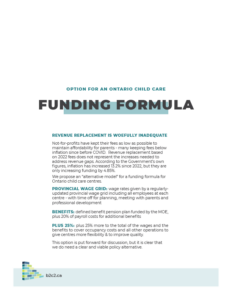Thanks to everyone who attended the meeting on May 29th to discuss Ontario’s Child Care Funding Formula. And thanks also to those of you who provided comments, feedback and suggestions.
The support encouraged us to distribute an alternative model for Ontario’s Child Care Formula for discussion, especially at the time of the release of the Ministry’s Funding Formula. We hope that it is imminent and that it is good!
The suggestions resulted in a few changes to the paper, including:
- We have emphasized the need to maintain existing salaries if they are higher than in the wage grid and not allow “red-circling”.
- We have changed the start-rate for an unqualified assistant from $22.00 to $25.00 to accord with the AECEO and OCBCC position and to take account of those who were concerned that we were promoting wages below a “living wage”.
- We have changed the categories of the supervisor.
- The need for a COLA for the wage grid
For those who were concerned about opting for a province-wide standard ignoring the many remote, Indigenous and francophone communities, we would emphasize that a provincial standard can still allow for regional flexibility, by establishing a transparent mechanism for increases that could be defined provincially and implemented by Consolidated Municipal Service Managers (CMSMs) and District Social Services Administration Boards (DSSABs). A mechanism for regional variances would need to be defined democratically and collaboratively, based on demographic evidence, and have clear points for review and revision.
B2C2 also agrees that moving towards a robust system of pay equity in the province of Ontario is an excellent long-term goal. Because municipal pay equity plans have not been maintained there are unfortunately many municipal workers earning significantly lower than the Ontario average wage, so work is needed to improve/change the proxy comparator designated for early childhood educators as well as pursuing this avenue assertively once the issues of process have been resolved in the courts. Until then, we believe that basing the wage grid on the provincial standard of the average provincial wage is a good way to demonstrate the underpayment of educators and to make it easy to understand why we need a wage grid with increased wages (and benefits) for all staff needs to be included in the upcoming Funding Formula.
The model has been tested by several child care centres across the province and we are pleased to report that the numbers have worked out for all. If you would like a copy of the sample budget, please email us at [email protected]. Once the Ministry Funding Formula has been announced, you will have a good point of comparison.
We welcome your feedback and suggestions and hope we can work together in the future to make CWELCC work and to realize the expansion that it’s needed.
Download the whole paper in PDF format: Option for an Ontario Child Care Funding Formula

Option for an Ontario Child Care Funding Formula
Download the whole paper in PDF format: Option for an Ontario Child Care Funding Formula
Sue Colley
Sue Colley
Chair of the Board of Directors
Building Blocks for Child Care
Option for an Ontario Child Care Funding Formula
Download the whole paper in PDF format: Option for an Ontario Child Care Funding Formula

